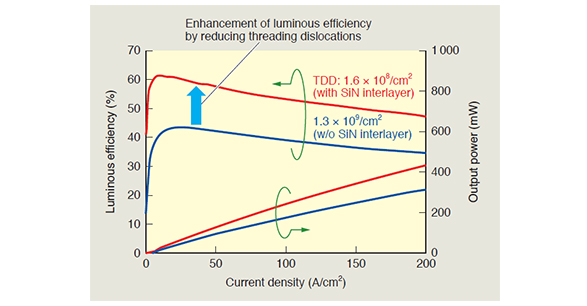- Back to the previous page
- Nano Materials & Devices
Enhancement of Luminous Efficiency of GaN-on-Si-Based Blue LEDs by Reducing Threading Dislocations
White LEDs are widely used in various applications, including general lighting and LCD TV backlighting. Gallium nitride (GaN)- based blue LEDs fabricated using large-diameter Si substrates are expected to serve as high-efficiency and low-cost light sources for LED lighting. However, because of the large lattice mismatch between the GaN crystal and the Si substrate, the GaN layer of an LED has a high threading dislocation density (TDD) on the order of 109 to 1010/cm2. The threading dislocations act as nonradiative recombination centers and limit the light-emitting efficiency of an LED.
To resolve this problem, Toshiba has developed a novel technology that uses a silicon nitride (SiN) interlayer to reduce threading dislocations. The newly developed technology provides a GaN layer on the Si substrate with a TDD as low as 1.6 × 108/cm2, which is comparable to that of a GaN layer formed on a conventional sapphire substrate. We have verified that GaN-on-Si-based blue LEDs fabricated using this TDD reduction technology exhibit enhanced luminous efficiency.

Luminous efficiency and light output power of GaN-on-Si-based blue LEDs
LCD: liquid crystal display


